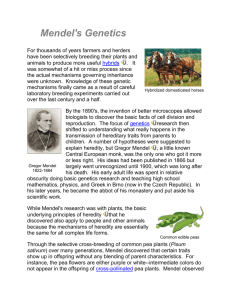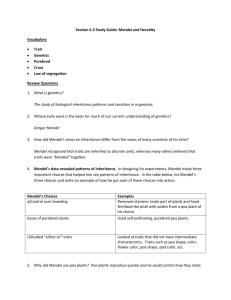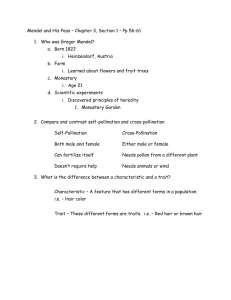Key Concept Builder
advertisement
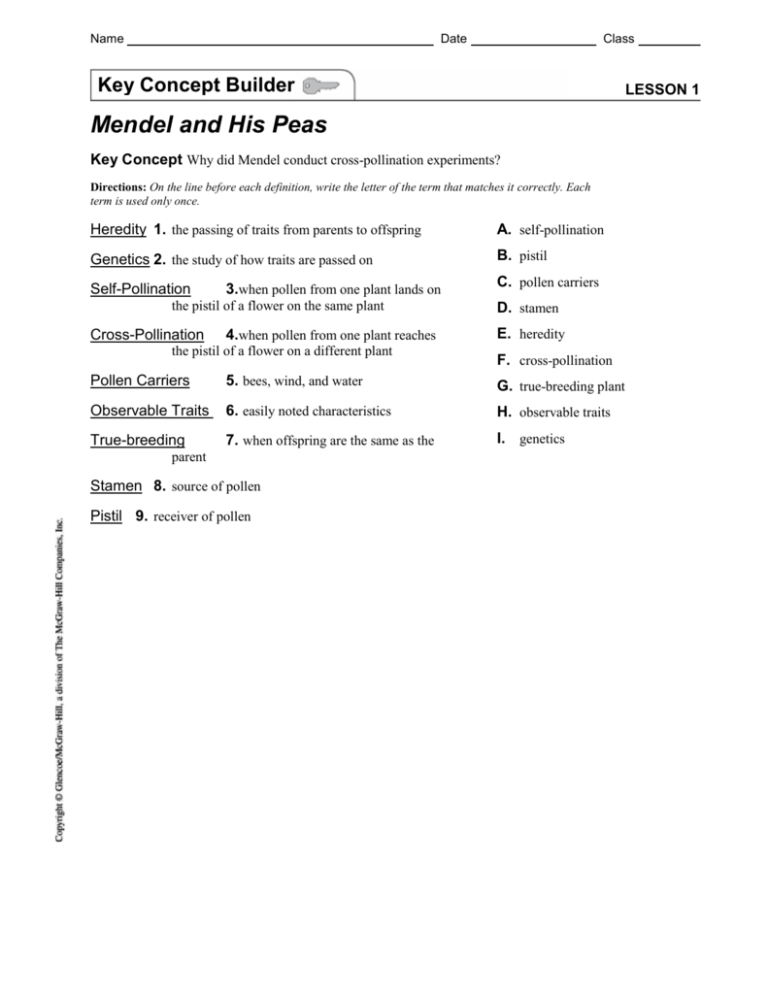
Name Date Class Key Concept Builder LESSON 1 Mendel and His Peas Key Concept Why did Mendel conduct cross-pollination experiments? Directions: On the line before each definition, write the letter of the term that matches it correctly. Each term is used only once. Heredity 1. the passing of traits from parents to offspring A. self-pollination Genetics 2. the study of how traits are passed on B. pistil Self-Pollination C. pollen carriers 3.when pollen from one plant lands on the pistil of a flower on the same plant Cross-Pollination 4.when pollen from one plant reaches the pistil of a flower on a different plant D. stamen E. heredity F. cross-pollination Pollen Carriers 5. bees, wind, and water G. true-breeding plant Observable Traits 6. easily noted characteristics H. observable traits True-breeding 7. when offspring are the same as the I. genetics parent Stamen 8. source of pollen Pistil 9. receiver of pollen Name Date Class Key Concept Builder LESSON 1 Mendel and His Peas Key Concept Why did Mendel perform cross-pollination experiments? Directions: On each line, write the term from the word bank that correctly completes each sentence. Each term is used only once. color hybrid cross-breeding length cross-pollination reproduce self-pollination traits true-breeding first second 1. Gregor Mendel experimented with pea plants because they reproduce quickly and have easily observed traits, and because he could control which plants reproduced. 2. Pollination in pea plants can occur in the following two ways: self-pollination or cross-pollination. 3. Mendel started with true-breeding plants—plants with the exact same characteristics from one generation to the next. 4. Those characteristics included the color of the flowers and the length of the stems. 5. By cross-breeding different pea plants, Mendel produced a variety of hybrid plants. 6. He noted that characteristics that were not present in a first-generation cross showed up in about 25 percent of the plants in a second-generation cross. 18 Genetics Name Date Key Concept Builder Class LESSON 1 Mendel and His Peas Key Concept What did Mendel conclude about inherited traits? In his experiments with pea plants, Mendel concluded that some traits are dominant and others are recessive. Directions: On the line before each trait, write D if it is dominant or R if it is recessive. R 1. white flowers D 2. purple flowers D 3. yellow seeds R 4. green seeds R 5. wrinkled seeds D 6. round seeds D 7. smooth pods R 8. bumpy pods R 9. short stems D 10. long stems Directions: On the line before each statement, write T if the statement is true or F if the statement is false. T 11. Mendel concluded that each trait he observed was controlled by two factors— one from the egg cell and the other from the sperm cell. T 12. He called them factors because nothing was known about genes in his time. F 13. He concluded that a recessive factor always blocks a dominant factor. Genetics 19 Name Date Key Concept Builder Class LESSON 1 Mendel and His Peas Key Concept How do dominant and recessive factors interact? Directions: On the line before each pea-pod cross, write the letter of the most likely outcome. B 1. a true-breeding purple-flower plant crossed with a true-breeding white-flower plant A. all white-flower plants B. all purple-flower plants C. mostly purple-flower plants C 2. a cross between two hybrid purple-flower plants (purple and white) A. all purple flower plants B. mostly white-flower plants C. mostly purple-flower plants C 3. a hybrid purple-flower plant (purple and white) crossed with a true-breeding white-flower plant A. all purple-flower plants B. mostly purple-flower plants C. half purple-flower plants and half white-flower plants Directions: Answer each question on the lines provided. 4. Why would it have been impossible for Mendel to create heterozygous pea plants with short stems, green seeds, or bumpy pods? All of the traits mentioned are recessive. Recessive traits have to be homozygous. 5. Out of the many hybrid pea plants that Mendel crossed, about what percent of the second-generation plants had a. the dominant form of each trait? 75% b. the recessive form of each trait? 25% 20 Genetics
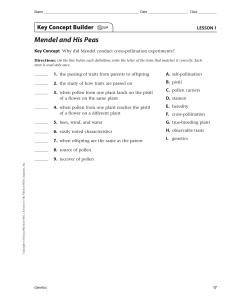
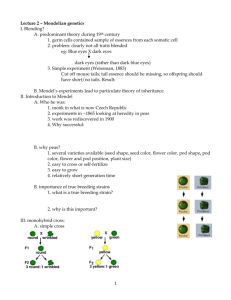
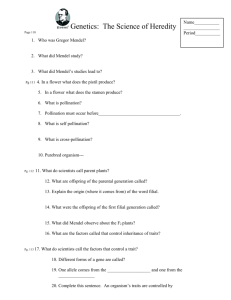
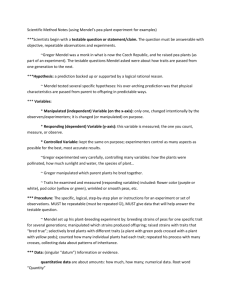

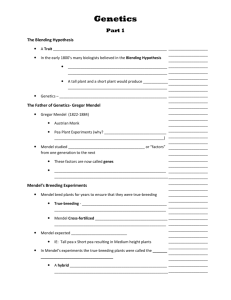
![Biology Chapter 3 Study Guide Heredity [12/10/2015]](http://s3.studylib.net/store/data/006638861_1-0d9e410b8030ad1b7ef4ddd4e479e8f1-300x300.png)
